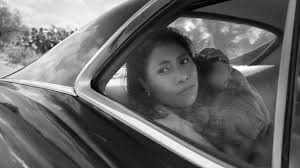Alfonso Cuarón’s Roma begins quietly and thoughtfully with the character, Cleo, played beautifully by Yalitza Aparicio, who serves a well-to-do family in their home in a suburb of Mexico City. Her life, seeming so insular and placid, will expand to engulf the film’s universe. Every action and word of hers has a hidden meaning, and minor gestures seen early in the movie will be echoed by more serious and violent actions later.
One of the pleasures of this film is in the lack of elements, which might be seen as absences – no score and no color. Despite these absences, the film is strengthened and deepened by the quiet and the lack of color. The film seems almost a documentary, something like The Battle of Algiers, but without the didactic element of that film. This film brings the sky, the wind, and all the natural world into the story, in the way Kurosawa and Bresson could make a riffle of wind or a passing cloud a character in their films. The absence of well-known actors is also a plus. It prevents the viewers from importing the biography, personal and cinematic, of that star into Roma.
The story moves from the intimate (love affairs, petty disputes, mundane worries) to larger political issues (class, revolution, and violence) in a way that is well-knitted and credible. There is no sense that some political backstory has been grafted onto the story of Cleo’s life, nor is her story a footnote to some central political and historical narrative.
Alfonso Cuarón (the director of Gravity, among other well-known films) is in full control, technically and thematically, and of his actors. There is no waste, no digressions, no moments when the flow of the film stalls or the tension slackens. Even the motifs of foreshadowing of actions, which could have been intrusive and wooden, seem inevitable and sensibly a part of the action.
So much to praise and so little room in this review, but the use of sound must be mentioned. Sounds seem to echo and move around the viewer – from the left to the right, in the background to the foreground, but again masterfully and organically. A sound brings the action onto the stage or signals a mood.
There is no end to the superlatives and comparisons I could make with this film, which grows quietly in your recollection after the final credits. Suffice it to say that this film is a bit of humanity and of art in the midst of a season of bombast and crudity. I can think of no film, certainly no film from other than past masters of the cinema, that provides the substance and room of reflection present in Roma.
Film review courtesy of Georges de Verges.
Featured image: Still from Roma|Teaser Trailer [HD] | Netflix
For further viewing and reading
Films
Gravity, available as DVD in Fondren, AV
Children of Men, available as DVD in Fondren, AV
Y tu mamá también, available as DVD in Fondren, AV
Books
Shaw, D. (2013). The three amigos : the transnational filmmaking of Guillermo del Toro, Alejandro González Iñárritu, and Alfonso Cuarón . Manchester, UK: Manchester University Press. Hamon, General Stacks PN1993.5.M4 S53 2013
Smith, P. (2014). Mexican Screen Fiction : Between Cinema and Television. Cambridge, UK: Polity. Hamon, General Stacks PN1993.5.M4 S65 2014
Richmond, S. (2016). Cinema’s Bodily Illusions : Flying, Floating, and Hallucinating. Minneapolis: University of Minnesota Press. Hamon, General Stacks PN1995 .R53 2016
